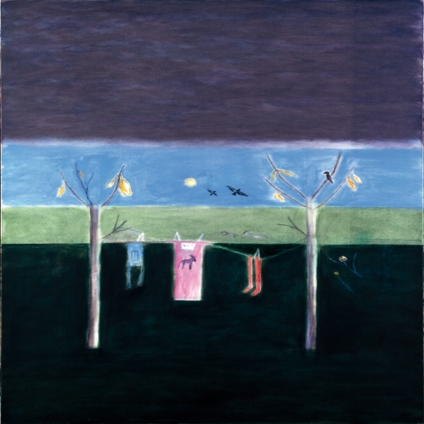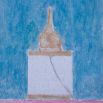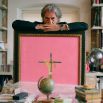The art of Craigie Aitchison RA is an exquisite essay in the sublime. It is the world pared down, Craigie distills images of beauty and simplicity.
Fields of pure colour are thinly applied that looks like scumble and form the back drops to his jewel like still lives, iconic portraits and lyrical landscapes often featuring a lone sheep and a sickle moon floating in a lapis lazulae crespuscule.
Painters invent their own world just as children do but we loose that childlike vision often struggling to get it back; however Craigie’s remains intact. His iconography is original and seldom derivative.
It is a misconception to think of his work as primitive or naive – far from it or to describe his fields of luminous colour like those of Rothko’s. Craigie’s painting echoes the early Renaissance frescoes of Giotto, Piero della Francesca and Fra Angelico and later the symbolism of Odilon Redon and the dream like qualities of Marc Chagall.
Craigie’s endearing imagery has remained untouched by the winds of art trends; it has none of the angst ridden art of Francis Bacon and he eschewed Pop art when the sixties swung.
For forty years he has remained utterly faithful to his inimitable style of painting, unwavering in his singular choice of subject matter and his razor-sharp compositions, imbued with stillness and serenity.
Born in Edinburgh in 1926 Craigie had a fairly austere upbringing, typical of the upper classes; boarding school followed by studying law. But he soon realised his true vocation, preferring not to follow in his father Lord Aitchison’s footsteps, the Lord Justice Clerk of Scotland.
By the early fifties bohemia beckoned and he moved to Mayfair and enrolled at the Slade School where he met his life long friends Myles Murphy and Euan Uglow. Winning a Rome scholarship proved cathartic for Craigie and Renaissance art had a profound effect on his work.
He and Myles motored all the way to Italy in a London taxi they bought for £45 (good for transporting canvases) but it only went at 35mph.
The taxi was classed as an illegal import and the legal wrangles nearly reached the threshold of the Vatican. Craigie’s present mode of transport is a pink Triumph Herald held together with bits of string.
In Rome ‘La Dolce Vita’ was in full swing but it was not the flamboyant Baroque and Rococo art of the eternal city that influenced Craigie but the milky opaque tones and faded colours of Tuscan Frescoes that had a lasting effect on his paintings.
Craigie has always refrained from cluttering his canvases and kept the clarity of composition of the early Renaissance at the back of his mind.
Even though he has lived in south London for most of his life none of the harshness of the concrete jungle has rubbed off on him for he is a gentle soul, but his shy demeanour belies a man with strong convictions, socialist principles and staunch opinions.
When he was elected as a member of the The Royal Academy he resigned over a portrait of Myra Hindley, the child murderess, made up of a composite of children’s handprints that was hanging in the Saatchi Sensation! show at the Academy.
He could not bare the mother of one of the victims of the ‘Moors murders’ standing outside the gallery and screaming for it to be taken down; while the hanging committee did not.
However Craigie was re-elected and in 1999 was made a Commander of the British Empire by the Queen thus firmly placing him in the art establishment as one of Britain’s best loved and admired painters with his feet solidly planted in the European tradition of art.
Beside an ante-diluvian bar heater his beloved Bedlingtons curl up on special cushions with Bedlingtons on them designed by Craigie and these darling dogs have been his lifelong companions and often appear like mythical beasts in his pictures.
We perch on a very small velvet couch and discuss various quotes by famous writers on Christ.
His largest canvases are often crucifixions, limp and poignant and convey none of the guilt inducing paint of Christ suffering; only melancholy. I asked him if that is what he intends?
“I just do it the way I do it;” he is recalcitrant about talking about his work; the ‘pictures’ as he always refers to them.
We quickly move onto gossip and as usual one hilarious anecdote after another comes tumbling out in between infectious giggles.
His work is in many museums, such as the Tate Gallery and the Scottish National Gallery, while Sir Elton John, Sir Paul Smith, and the playwright Sir Tom Stoppard, as well as Harry Potter Daniel Radcliffe are among his ardent fans and collectors, the art patron Sheelagh Cluney has fifty of his paintings.
He has also received numerous prizes including the Johnson wax award (a furniture polish company) and when asked what he was going to do with his £20,000 prize money he quipped “I’m going home to polish the furniture.”
Whenever people walk into his house they say it feels like going into a Craigie 3d painting. The walls are painted in pinks, canary yellows and ceruleum blues and every flat surface is cluttered with ornaments and kitsch, that have often been part of still lives-the pictures depart but the objects stay.
Birds alight on tiny ashtrays, empty glasses jostle with old fancy scent bottles on tiny gilt occasional tables reminiscent of a more opulent era gone by. How his Scotch cousin had to watch Rory McEwen play his guitar every evening on telly and would rush to take her hair curlers out before he came on lest he should see her through the screen on the other side.
I try to steer him back to painting and his early years at the Slade where he was taught by the exacting Sir William Coldstream; the life room was a forest of plumb lines and every mark a student made on the paper had to be measured and re-measured for absolute accuracy and perspective and perfect proportions. “At the Slade we were taught it was far too complicated to try and paint without getting the marks in the right place.”
However the obsessive measuring has never stopped him from editing out extraneous detail to achieve meditative canvases that sing to you with their vibrant colours and emblematic imagery.
His first mentor and dealer Helen Lessore, director of the Beaux Art gallery commented on the ‘Japanese spacing’ in Craigie’s pictures. It is this Japanese aesthetic, the zen simplicity, quiet spirituality and purity that pervades his work.
In his still lives there is a definite sense of ‘wabi’ for which there is no Western equivalent. Wabi identifies beauty with unpretentious, simple, unfinished and transient things; for instance there is wabi in old ill matching sets of crockery, just as Craigie might paint a radio, a set of mugs, a sugar bowl or a washing line.
Some twenty paintings travelled to Tokyo for an exhibition at Paul Smith’s Space Gallery spring 08. Sir Paul befriended Craigie when his wife went to the Slade.
“I bought two of his paintings; one of man on a donkey and another of a clothes washing line, as well as a large print of a crucifixion. I am hoping that the Japanese love his work and think it kawai kawai (pretty pretty).”
Craigie’s use of colour is pure, straight out of the tube and without tone, he uses only a little turps and he just “itches’ the colour onto the canvas while he uses the blue floorboards of his studio as his palate.
The result is a fresco like quality especially when he is painting in his house in Tuscany where cypress trees often appear in his pictures.
“You can’t live there without wanting to paint them. The trees here are all too fat and muddled.”
Recently, suffering serious illness, Craigie spent some time in hospital. He tried to rehabilitate himself.
“I was desperate I couldn’t do the pictures and I resorted to looking at my catalogues and getting the theatre designer Simon Beresford to copy the outlines pictures and I simply coloured them in.” Rather like a child would do.
“I did this for two months. Then I woke up one morning and thought ‘this is really boring just to be colouring in your own pictures’ and went back to the real pictures.”
Craigie leads me up to his studio at the top of the house and I have a vivid Proustian hit recalling sitting for him as a young art student 25 years ago. The portrait had verisimilitude, capturing my wistful expression and features perfectly, and it appeared in Vogue in an article about ‘The English Woman’s Face’.
Yellow canaries flew around the yellow painted studio and Craigie plied me with vodka tonics and his favourite egg sandwiches so that I would not get too bored-but I never did for Craigie is wonderful company.
This in no way prepared me for the tough sessions modelling for his best friend Euan Uglow some months later. A large half finished crucifixion sits on an easel Euan gave him 40 years ago.
When the portrait was finished Craigie gave me a painting of a canary looking into his reflection in a mirror. It is my most treasured possession.
Celia Lyttelton, 2008
—
Addendum, February 2012
Craigie died peacefully in his bed which his great friend Euan Uglow made with a gold leaved headboard and single small chandelier, after a bibulous lunch in Claridge’s with one his many adoring friends Charlotte Black.
Few people could command such a following of loyal friendship, his popularity was testimony to his unerring loyalty and generosity; checkbook in hand he would always pick up the tab no matter how many were dining.Recently the contents of his house including all his ornaments an bric a brac went up for auction therefore dispersing his tableaux and studio still lives for ever, the last vestiges of his life and art went up in a cloud under the hammer.
This auction showed scant respect for what should have been kept as one collection and a small museum in memory of his life's work.
Enough said when Craigie died the colour drained out of my life for a while and the world turned monochrome.
Celia Lyttelton, 2012
Estate of Craigie Aitchison
 Perfume Bottle, 2006, oil on canvas - Craigie Aitchison RA, courtesy Timothy Taylor Gallery, London and Waddington Galleries, London.
">Sir Paul Smith with Crucifixion by Craigie Aitchison RA, oil on canvas - photo: Andrew Lamb">
Perfume Bottle, 2006, oil on canvas - Craigie Aitchison RA, courtesy Timothy Taylor Gallery, London and Waddington Galleries, London.
">Sir Paul Smith with Crucifixion by Craigie Aitchison RA, oil on canvas - photo: Andrew Lamb">Perfume Bottle, 2006, oil on canvas - Craigie Aitchison RA, courtesy Timothy Taylor Gallery, London and Waddington Galleries, London. ">
 Winter Washing Line, Montecastelli, 2000, oil on canvas - Craigie Aitchison RA, courtesy Timothy Taylor Gallery, London and Waddington Galleries, London.
">
Winter Washing Line, Montecastelli, 2000, oil on canvas - Craigie Aitchison RA, courtesy Timothy Taylor Gallery, London and Waddington Galleries, London.
"> Sir Paul Smith with Crucifixion by Craigie Aitchison RA, oil on canvas - photo: Andrew Lamb">
Sir Paul Smith with Crucifixion by Craigie Aitchison RA, oil on canvas - photo: Andrew Lamb">
Acheter paris viagra pas cher france toulouse.
Vente en france achat de cialis en pharmacie fort-de-france.
Acheter sans risque cialis generique pas cher reims.






















